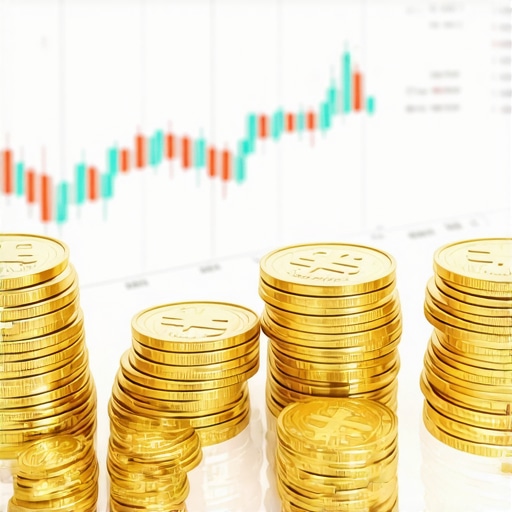Understanding Gold Market Analysis: A Crucial Skill for Investors
As the allure of gold continues to captivate investors around the globe, navigating the complexities of the gold market analysis becomes essential. Gold has stood the test of time as a safe haven asset, especially during periods of economic uncertainty. However, understanding how to analyze the gold market is vital for making informed investment decisions. This guide will provide insights into the key factors that influence gold prices, enabling you to approach your investments with confidence.
What Are the Key Factors Affecting Gold Prices?
The value of gold is influenced by a myriad of factors, including supply and demand dynamics, economic indicators, and geopolitical events. For instance, central bank policies often play a pivotal role in shaping gold prices. According to a source from Investopedia, central banks are significant players in the gold market, buying and selling large quantities which can sway prices dramatically.
In addition to central bank actions, inflation rates are another crucial element that impacts gold prices. Typically, when inflation rises, investors flock to gold as a hedge against currency devaluation. This behavior further drives up the demand and price of gold. Furthermore, economic stability or instability can influence gold’s attractiveness; during turbulent times, investors often seek to secure their wealth in tangible assets like gold.
Strategies for Effective Gold Market Analysis
To successfully navigate the gold market, investors should adopt a multi-faceted approach to analysis. Here are a few strategies:
- Technical Analysis: This involves studying historical price movements and utilizing various chart patterns to predict future price action.
- Fundamental Analysis: Focus on the underlying economic factors that drive gold prices, such as interest rates, inflation, and geopolitical stability.
- Sentiment Analysis: Gauge market sentiment by observing investor behavior, news trends, and social media discussions surrounding gold.
By combining these analytical methods, you can develop a comprehensive understanding of the gold market, allowing you to make informed investment choices.
As you embark on your journey in gold investment, consider exploring our detailed post on navigating today’s gold market for more strategies and insights.
Have you started analyzing the gold market yet? Share your thoughts and experiences in the comments below!
Understanding Gold Investment Strategies
Investing in gold isn’t just about purchasing the metal; it requires a comprehensive understanding of market strategies and timing. With the fluctuating nature of gold prices influenced by various global factors, having a strategy in place can enhance your investment success. Many investors opt for gold as a hedge against inflation and economic downturns, making it crucial to understand how to effectively navigate this market.
How Can You Analyze Current Gold Demand Trends?
To analyze current gold demand trends effectively, consider following key indicators: global economic health, currency strength, and interest rates. The World Gold Council highlights that demand for gold can be segmented into various categories like investment, jewelry, and technology. Understanding these segments provides a clearer picture of where demand is headed and how it may influence prices. For instance, during times of economic uncertainty, investment demand typically increases, pushing prices higher.
Moreover, staying updated on geopolitical events is essential. Events such as elections, trade disputes, and international conflicts can affect market sentiment and demand for gold. For detailed insights, you can refer to the Wikipedia page on the gold market, which outlines the various factors affecting demand and pricing.
Utilizing Technical Analysis in Gold Trading
Technical analysis plays a pivotal role in gold trading. This method involves examining historical price charts to identify patterns and trends that can predict future movements. Traders often look for specific indicators such as moving averages or relative strength index (RSI) to determine entry and exit points. By combining these technical indicators with fundamental analysis, investors can make more informed decisions.
What Are the Benefits of Diversifying with Gold?
Diversification is a key strategy in risk management, and gold provides an excellent opportunity for this. Incorporating gold into your investment portfolio can mitigate risk during market volatility. Historically, gold has shown a low correlation with stocks and bonds, making it a valuable addition to a diversified portfolio. As you consider your investment options, check out our post on physical gold vs. gold ETFs to understand which option may fit your investment style better.
Are you currently using any specific strategies for investing in gold? Share your experiences or ask questions in the comments below! Engaging with fellow investors can provide valuable insights and enhance your understanding of the gold market. Stay tuned for more strategies and tips in our upcoming sections!
Maximizing Your Gold Investment: Key Insights and Strategies
As you delve deeper into the world of gold investment, understanding how to maximize your returns becomes increasingly important. With the right strategies in place, you can enhance your portfolio’s performance and better navigate the fluctuations of the gold market. Here are some vital insights to consider for optimizing your investments.
What Are the Most Effective Strategies for Investing in Gold?
Investors often wonder about the best approaches to take when investing in gold. Some tried-and-true strategies include:
- Dollar-Cost Averaging: This strategy involves investing a fixed amount of money into gold at regular intervals, regardless of the price. This method helps mitigate the risk of price volatility over time.
- Hedging Against Inflation: Gold is historically viewed as a hedge against inflation, making it an attractive option when economic conditions suggest rising prices. Investors can allocate a portion of their portfolio to gold to protect against currency devaluation.
- Utilizing Gold ETFs: Gold exchange-traded funds (ETFs) offer a convenient way to invest in gold without the need for physical storage. ETFs track the price of gold and can be traded like stocks, providing liquidity and flexibility.
To explore more about these strategies, check out our guide on understanding gold ETFs and their benefits for new investors.
Analyzing Global Economic Indicators
Being aware of global economic indicators is vital for successful gold investment. Key indicators include:
- Interest Rates: When interest rates are low, the opportunity cost of holding non-yielding assets like gold decreases, making gold more attractive.
- Currency Strength: A weaker US dollar often leads to higher gold prices, as gold becomes cheaper for foreign buyers.
- Geopolitical Stability: Events such as elections, wars, or international conflicts can lead to increased gold demand as investors seek safe-haven assets.
According to a report from the World Gold Council, understanding how these indicators interplay can provide valuable insights into market trends and potential price movements.
People Also Ask: How Can I Stay Updated on Gold Market Trends?
Staying informed is crucial in the fast-paced world of gold investments. Here are a few effective ways to keep abreast of market trends:
- Follow Reputable Financial News Sources: Websites like Bloomberg and CNBC offer up-to-date news on economic indicators and gold prices.
- Utilize Market Analysis Tools: Many platforms provide analytical tools and charts that can help you visualize price movements and trends.
- Engage with Online Communities: Joining forums or social media groups focused on gold investment can provide insights and share strategies with like-minded individuals.
By following these steps, you can make more informed decisions and navigate the complexities of gold market analysis effectively.
What strategies have you found successful in your gold investment journey? Feel free to share your thoughts and experiences in the comments below! For more insights on gold investment strategies, explore our post on gold investment strategies for 2025 to stay ahead of the curve!
Understanding the Dynamics of Gold Price Movements
The fluctuations in gold prices are often tied to a variety of economic and geopolitical factors. Recognizing these dynamics is crucial for investors aiming to optimize their gold investment strategies. For instance, shifts in currency strength, especially the US dollar, can significantly influence gold prices. A weaker dollar typically results in higher gold prices, as it becomes cheaper for buyers using other currencies.
How Do Global Events Influence Gold Demand?
Global events, such as geopolitical tensions or major economic shifts, can lead to increased demand for gold as a safe-haven asset. According to the World Gold Council, during periods of uncertainty, investors often flock to gold, driving up its price. Understanding these patterns can help you anticipate market movements and adjust your investment strategy accordingly.
Additionally, economic reports like employment data, inflation rates, and central bank announcements can provide insight into future gold price trends. By monitoring these indicators, investors can make more informed decisions on when to buy or sell their gold assets.
Leveraging Gold as a Hedge Against Market Volatility
Gold is widely recognized as a hedge against inflation and market volatility. When equity markets decline or inflation rises, gold often maintains its value or even appreciates. This makes it a strategic component of a diversified investment portfolio. Investors looking to protect their assets against economic downturns should consider allocating a portion of their portfolio to gold.
For those interested in exploring how to build a balanced portfolio with gold, check out our detailed guide on building a gold investment portfolio.
People Also Ask: What Are the Best Practices for Buying Gold?
When considering purchasing gold, it’s essential to follow best practices to ensure you make sound investment decisions. Here are some tips:
- Research Reputable Dealers: Always buy from established dealers with good reviews and transparency in pricing.
- Understand Different Forms of Gold: Know the differences between gold bars, coins, and ETFs, as each has unique benefits and drawbacks.
- Stay Informed About Market Trends: Regularly review market analyses and reports to keep up with price movements and economic indicators.
By adhering to these practices, you can enhance your chances of making successful gold investments.
Have you considered how gold fits into your overall investment strategy? If so, we invite you to share your thoughts in the comments below! For more insights and expert strategies on gold investments, explore our comprehensive articles on the role of gold in a balanced investment portfolio and gold investment strategies for 2025. Engaging with fellow investors can provide valuable insights and enhance your understanding of the gold market.
Frequently Asked Questions (FAQ)
1. What factors should I consider when investing in gold?
When investing in gold, consider factors such as global economic conditions, inflation rates, currency strength, and geopolitical events. Understanding these elements can help you make informed decisions and optimize your investment strategy.
2. How can I effectively analyze gold market trends?
To analyze gold market trends effectively, use technical analysis (historical price movements), fundamental analysis (economic indicators), and sentiment analysis (investor behavior). Combining these methods provides a comprehensive view of market dynamics.
3. Is it better to invest in physical gold or gold ETFs?
Both physical gold and gold ETFs have their advantages. Physical gold provides tangible asset security, while gold ETFs offer liquidity and ease of trading. Your choice should depend on your investment goals, risk tolerance, and storage considerations.
4. How does inflation impact gold prices?
Typically, when inflation rises, gold prices tend to increase as investors seek gold as a hedge against currency devaluation. This demand can drive up prices, making gold an attractive investment during inflationary periods.
5. What are the best practices for buying gold?
When buying gold, always research reputable dealers, understand different gold forms (bars, coins, ETFs), and stay informed about market trends. This knowledge enhances your investment decision-making process.
6. How can I diversify my investment portfolio with gold?
Diversifying with gold can be achieved by allocating a portion of your portfolio to gold investments, whether through physical gold, gold ETFs, or gold mutual funds. This strategy helps mitigate risks associated with market volatility.
7. What role do central banks play in the gold market?
Central banks significantly influence the gold market through their buying and selling activities. Their policies can impact gold demand and prices, making them a critical factor for investors to monitor.
8. How often should I review my gold investment strategy?
Regularly reviewing your gold investment strategy is essential, ideally every six months, or more frequently during significant economic changes. This practice helps ensure that your strategy aligns with market trends and personal financial goals.
9. Can gold investments protect against economic downturns?
Yes, gold is often viewed as a safe haven during economic downturns. Its historical performance during market volatility supports its role as a protective asset in investment portfolios.
10. Where can I find reliable information on gold market trends?
Reliable information on gold market trends can be found through financial news websites, market analysis tools, and reports from organizations like the World Gold Council. Engaging with investment communities can also provide valuable insights.
Authoritative Sources
1. World Gold Council – A leading authority on gold market insights and trends, providing valuable data for investors.
2. Investopedia – Offers educational resources and articles on gold investment strategies and market analysis.
3. Bloomberg – A reputable financial news source that covers economic indicators and gold price movements.
4. CNBC – Provides up-to-date news and analysis on the gold market and global economic trends.
5. Forbes – Features expert insights and articles on gold investment and market strategies.
Conclusion
In summary, maximizing your gold investment requires a deep understanding of market dynamics, careful analysis, and strategic planning. By leveraging various investment strategies and staying informed about global economic factors, you can enhance your portfolio’s performance. Remember, gold serves as a hedge against inflation and market volatility, making it a crucial component of any diversified investment strategy. We encourage you to share your thoughts, ask questions, and engage with fellow investors in the comments below! For more insights, consider reading our article on gold investment strategies for 2025 to stay ahead in your investment journey.









